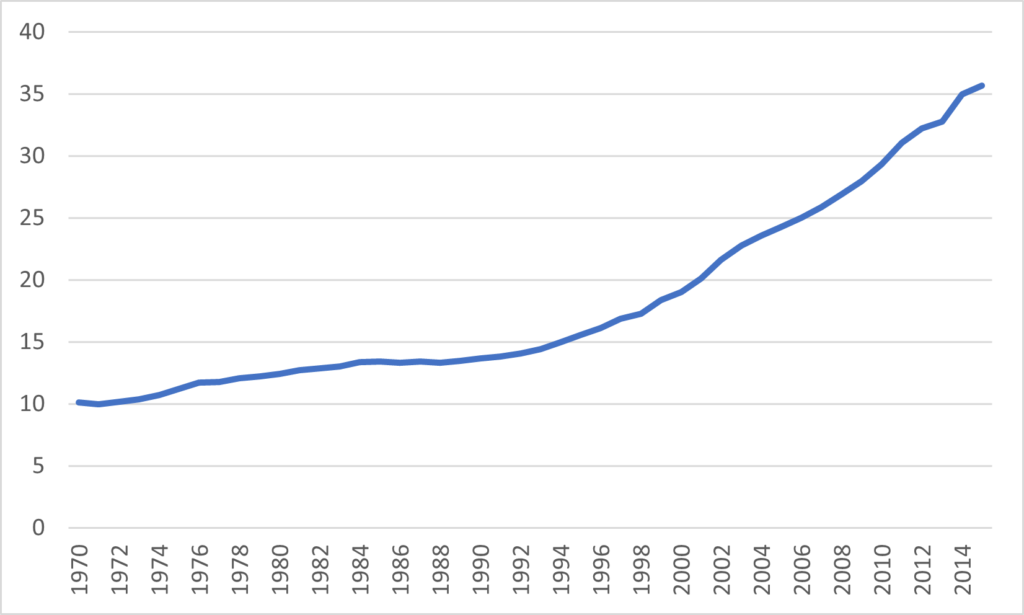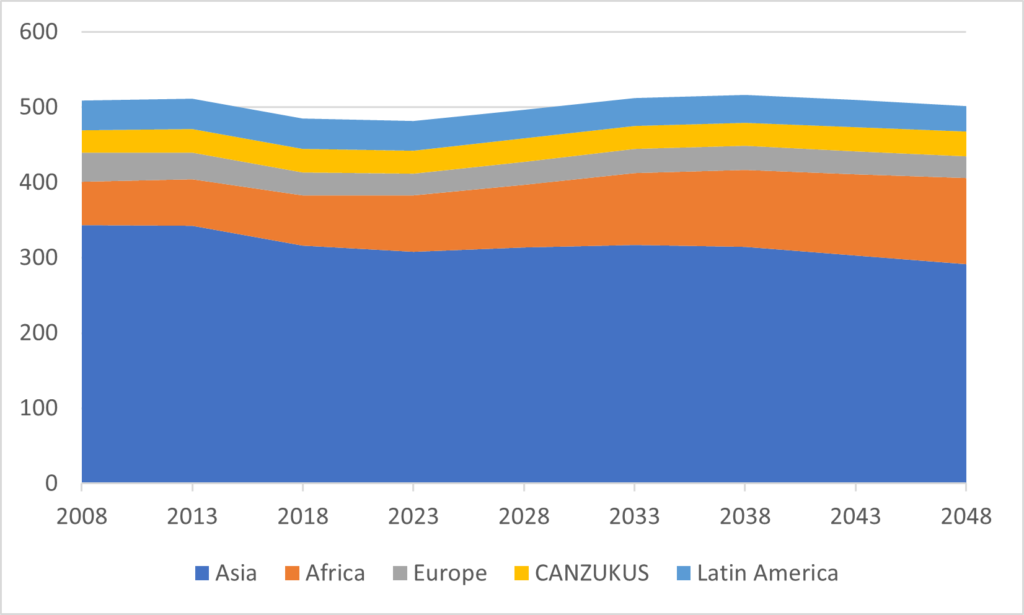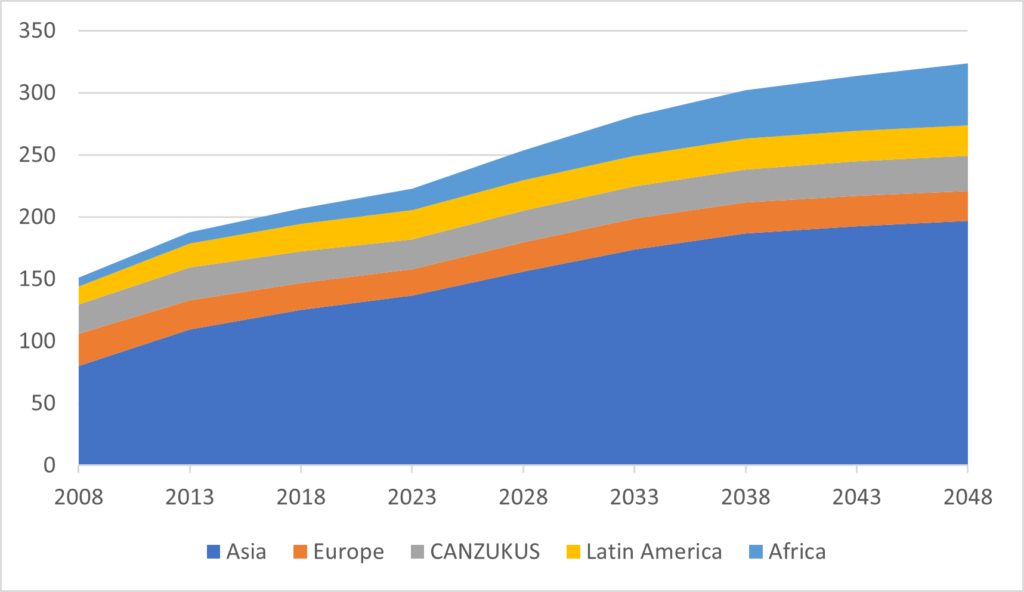Thinking about the future of higher education is my bread and butter. For the last few months, I have been thinking about the extreme long-term and wondering what it all portends for the shape and function of institutions globally. I’ll share a little bit of what I have been thinking today.
If we take a long view – say back to the 1960s, we see a continual increase in the enrolment of students in higher education (which, for the higher education stat nerds out there, means ISCED level 5 or above). Around the time of the Cuban missile crisis, global enrolment in higher education was a touch over 15 million or so, with roughly half of these students located either in the United States or the Soviet Union. By the late 2010s, we were looking at a world with something in the range of 225 million students, which implies a growth rate of about 5% per year, every year, for 65 years (although in truth growth rates were lower than that for most of this period and higher in the period from about 1998 to 2013). This kind of growth has come to be seen as “normal”. But will it stay that way?
The thing to remember is that higher education enrolments are a function of two things: first, the size of the youth population (because, whatever else they may be, these institutions are still overwhelmingly used as a kind of finishing school for learners in their late teens and early twenties), and second, the percentage of that cohort which is choosing and able to attend this kind of education. These numbers have been rising for most of the past 65 years. Figure 1 shows that change in the numbers of youth aged 20-24 by region (the awkwardly acronym there stands for Canada, Australia, New Zealand, US and UK), while figure 2 shows the change of the global participation rate. Note that for the population figures I am specifically looking at the 56 countries HESA covered in World Higher Education: Institutions, Students and Funding, so the totals are a bit low, but the trends are still basically correct. Data for figure 2 is from the World Bank.
Figure 1: Population Aged 20-24 by Continent, in millions, 1963 to 2013

Figure 2: Global Participation Rate in Tertiary Education, 1970 to 2015

So, up to late 2000s, the population has increased by 2.5x and the gross enrollment rate (that is, the total number of students divided by the youth population) increased by roughly 3.5x over our period of interest. All looks rosy, right? Straight-line projections would suggest that we are going to keep increasing, right?
Well, not so fast. Check out figure 3 which shows that we have hit peak global 20-24 year-olds about ten years ago and are already in a bit of a demographic trough. And while youth numbers will grow a bit later this decade, mostly what is happening is a shift in numbers from Asia, Europe and Latin America to Africa.
Figure 3: Projected Population Aged 20-24 by Continent, in millions, 2008 to 2048

What that means is that if there is going to be any kind of increase in higher education numbers globally, it is going to have to come from increasing participation rates. The problem is that there appear to be some theoretical maxima here, because not all youth end up in higher education. Across the Global North, participation rates have been relatively steady at between 70-80% since the mid-oughts. Occasionally you get some individual outliers like Australia which go over 100% because they import so many students from other countries, but that doesn’t work at a global level unless we discover other intelligent life forms in the cosmos and start giving them student visas (or, perhaps more reasonably, start educating more people who are not of traditional student age, of which more below.)
Looking at the likely pattern of flattening growth rates, I came up with an estimate of what participation rates will look like worldwide over the next 30 years or so. Broadly speaking, I am bullish about overall growth rates – we aren’t going to see a doubling every 15 years as we did around the turn of the century, but there is every chance that we will see a doubling over thirty years, mainly because there is still quite a ways to go to hit North-American style participation rates in China, and the two remaining sources of population growth – India and Africa – are currently at the very low end of participation rates. Figure 4 shows where I think higher education participation rates are heading over the next thirty years.
Figure 4: Projected Participation Rates by Continent, 2008 to 2048

Now, if you multiply Figures 3 and 4, you get Figure 5, which essentially says that global higher education numbers will continue to grow, but at a much slower pace than they did in the 1998-2013 boom. We are looking instead at global growth rates in the range of 1.5% per year from 2023 to 2028 and then declining towards 1% per year by the mid-2040s. Further, over 90% of the growth will occur in Asia and Africa, which suggests that the centre of gravity for global academia will continue to move away from North Atlantic. That has big implications for anyone thinking about where they want to start partnership agreements.
Figure 5: Projected Tertiary Enrolments by Continent, in millions, 2008-2048

Now, these numbers are probably a bit of an undercount – they are based on current enrolment rates in 56 countries which currently make up about 92% of global enrolments and so tend to systemically exclude countries which currently have small higher education systems but will be significantly larger in thirty years (for instance, parts of East Africa and Central Asia) as well as countries that are currently significant but which publish no data on higher education (e.g. Sudan & DR Congo). So, one might nudge up the totals and even tilt the slope of the lines a tiny little bit. You might get another few million out of that to reach 350 million students instead of 320 million. But basically, declining rates of absolute growth is the key story here.
Of course, the flip side of this growth picture is that the Americas and Europe are basically in for three decades of stagnation, number-wise. Numbers in Europe and Latin America look to peak in 2038 and decline thereafter; the CANZUKUS group is already in decline (entirely because of the United States), and while it will recover, numbers in 2048 aren’t likely to be more than about 10% higher than they were in 2018.
In these regions, I expect there will be ever-more desperate attempts to try to get non-traditional students into higher education because those systems will have a hard time transitioning to low-growth and the funding implications that entails. But those countries are also, almost certainly also going to have the most intense labour shortages due to demographic change, meaning that attending school will be ever-more expensive because of higher opportunity costs. I am pretty sure this will put a lot of pressure to create ever-shorter post-baccalaureate credentials in these countries.

 Tweet this post
Tweet this post

Thank you for the insights! I’m particularly interested in projections of women’s participation in education may change over this time period for students in Asia and Africa – both in their respective domestic regions and as international students. I will be investigating the issue and would love to hear any thoughts you may have on this.